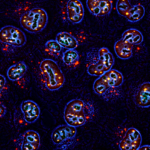Lien vers Pubmed [PMID] – 7545807
Oncogene 1995 Sep;11(5):871-6
The PML protein concentrates within discrete nuclear structures known as nuclear bodies, also called NDs or PODs, which contain several proteins including the interferon (IFN)-inducible SP100 product. The function of these structures remains elusive. We and others have shown recently that they represent specific targets for adenovirus and herpes simplex virus. This prompted us to investigate whether PML, like SP100, might be induced by IFN and to explore the role of PML in viral infection. Here we report that PML mRNA levels increase rapidly in response to interferon treatment. This accumulation of PML transcripts is a primary IFN response since it does not require de novo protein synthesis. The IFN-induced activation of the PML gene is accompanied by enhanced protein expression as revealed by immunolabelling. Both the intensity of the staining and the number of labelled structures increased upon interferon exposure. To probe the role of PML in IFN action, we compared the antiviral state established by alpha-interferon in embryonic fibroblasts (EFs) derived from null mutant mice for PML and from wild-type control mice. The resistance to viral infection conferred by IFN-alpha was identical in both PML+/+ and PMLm/m fibroblasts indicating that PML is not an essential mediator of the antiviral effect of interferon. We also noted that DNA-binding factors are normally activated by IFN in PMLm/m cells.

